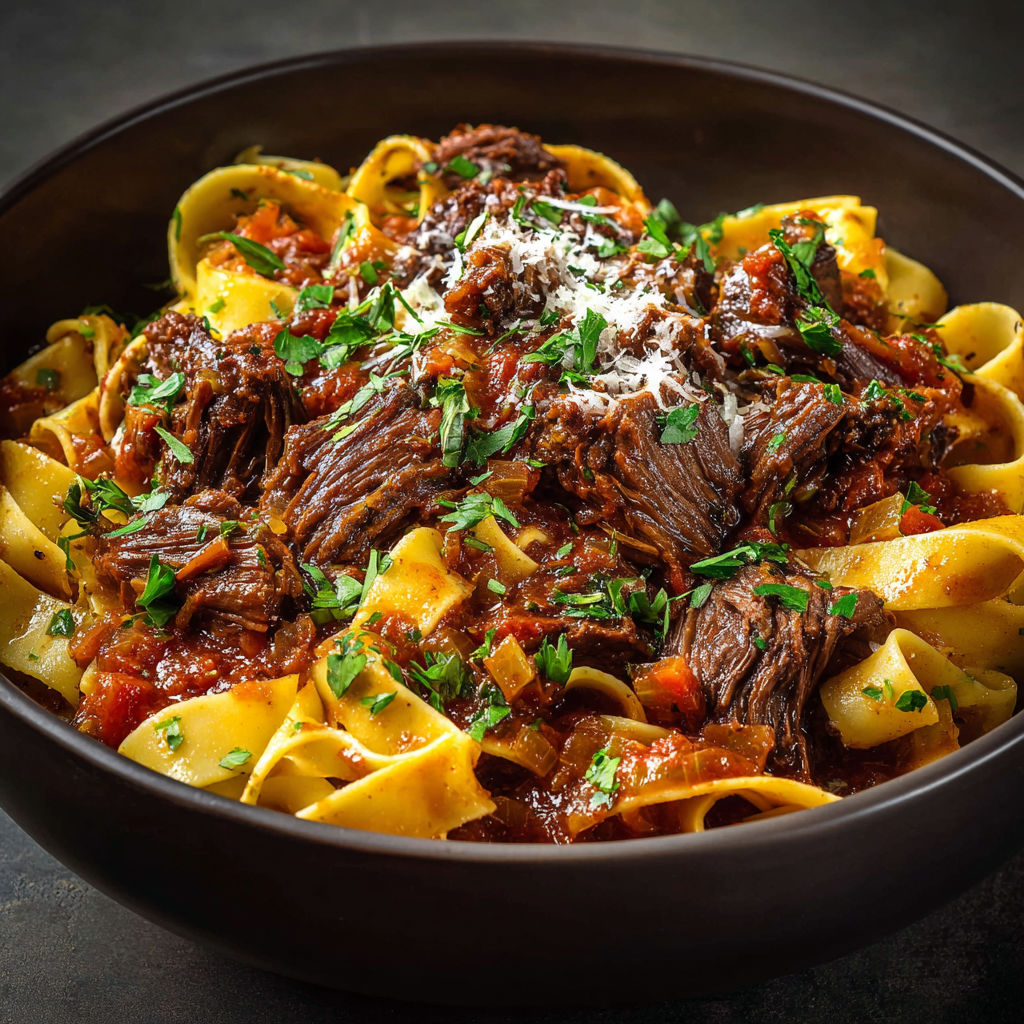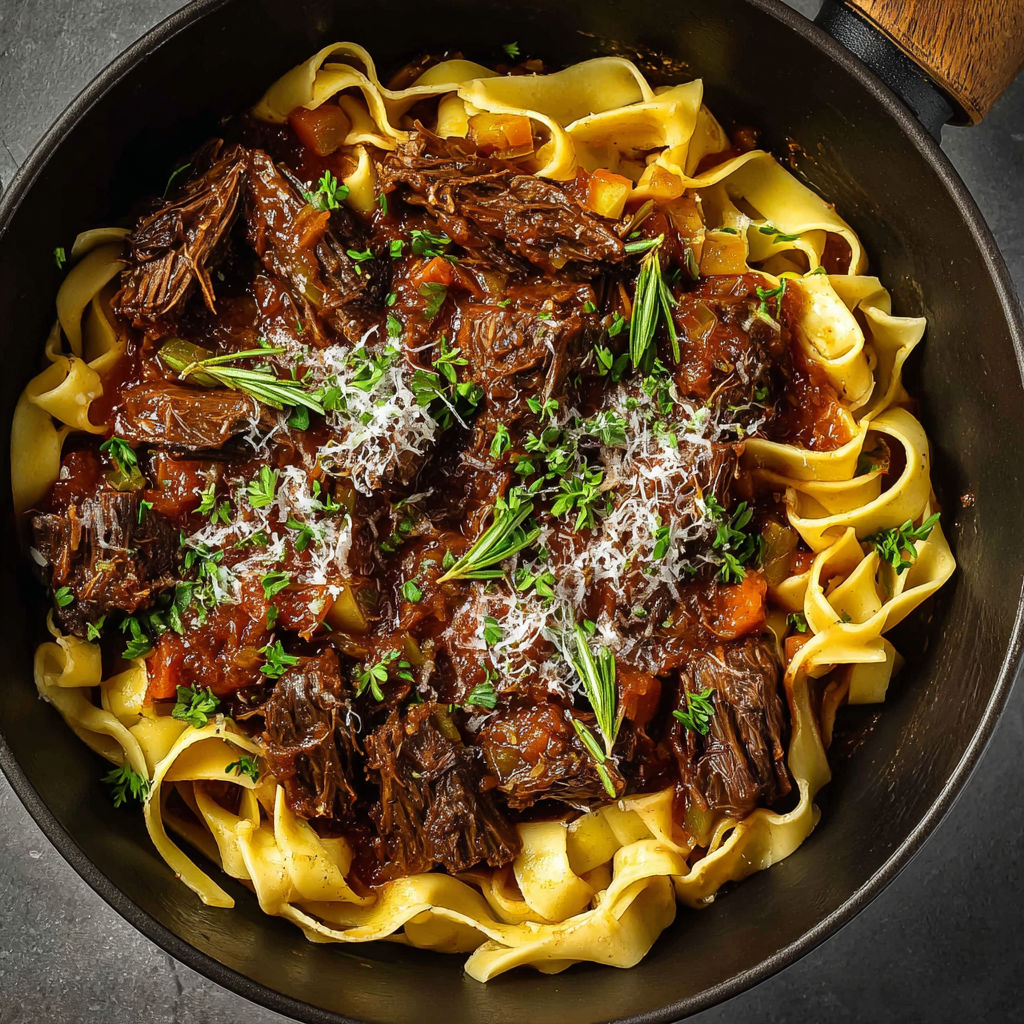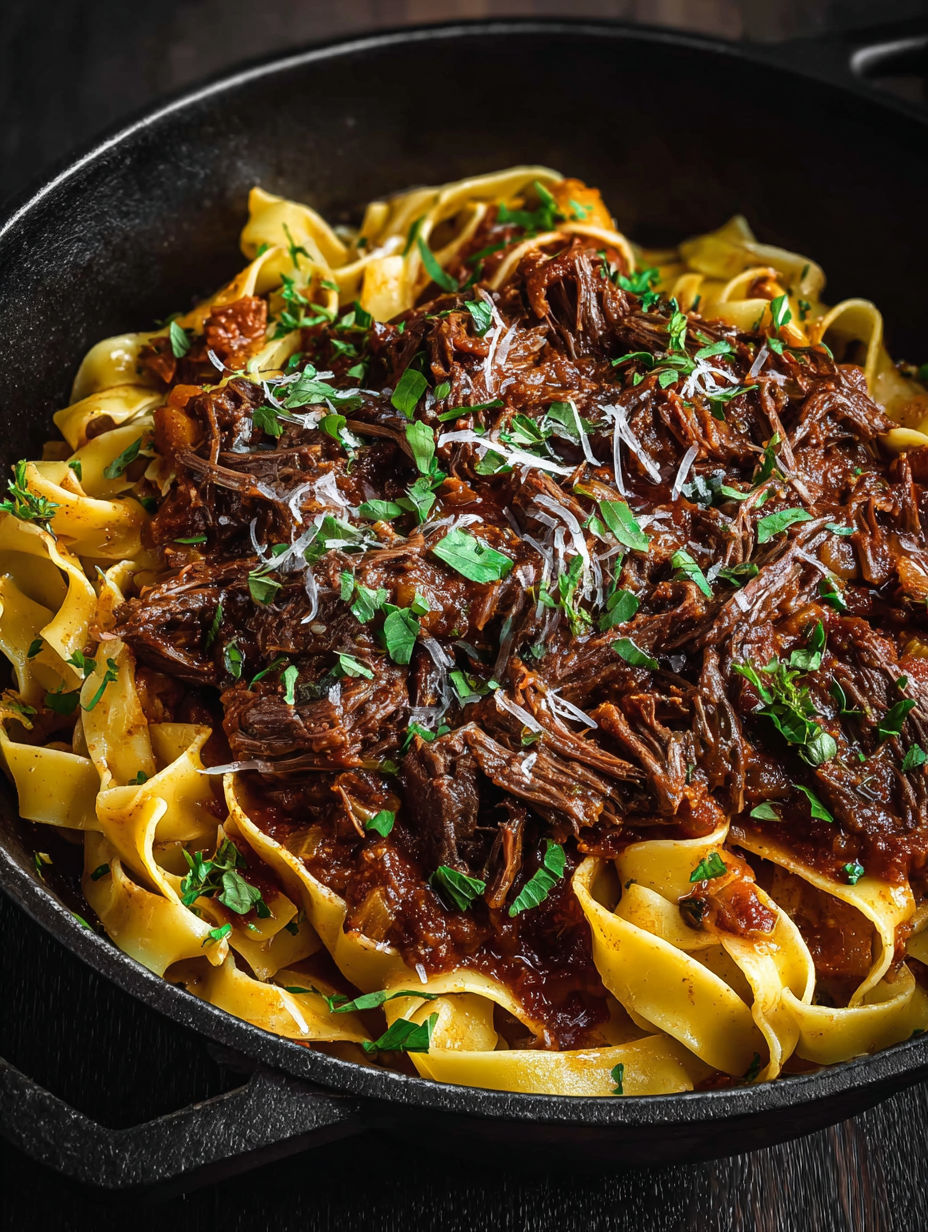 Pin
Pin
This hearty short rib ragù transforms humble ingredients into an indulgent pasta sauce through slow cooking. The rich, savory flavor comes from properly searing the meat and allowing it to simmer until it's fork-tender and falling apart. Though it requires patience, most of the cooking time is hands-off, rewarding you with an impressive dish perfect for Sunday dinners or special occasions.
I first made this ragù during a cold winter weekend when I needed something comforting but impressive enough for guests. The transformative process of turning tough short ribs into meltingly tender meat converted even my most skeptical dinner companions into believers. Now it's requested whenever someone special comes to visit.
- Beef short ribs provide rich flavor and become incredibly tender when slow-cooked properly select meaty pieces with good marbling for the best results
- Light olive oil for searing the meat without imparting too strong a flavor you can substitute vegetable or avocado oil
- White onion carrot and celery create the classic flavor base known as soffritto in Italian cooking
- Garlic cloves add aromatic depth use fresh cloves rather than pre-minced for better flavor
- Tomato paste contributes concentrated umami and helps thicken the sauce look for double-concentrated paste in tubes for best flavor
- Red wine adds acidity and depth choose a medium-bodied wine you would drink
- Crushed tomatoes provide texture and brightness San Marzano tomatoes offer superior flavor if available
- Herb bundle with rosemary thyme and parsley stems infuses the sauce with aromatics without leaving bits in the final dish
- Bay leaves impart subtle complexity remove before serving
- Sherry or red wine vinegar brightens the rich sauce with a touch of acidity
- Pasta preferably a wider cut like pappardelle or tagliatelle which stands up to the hearty sauce
How To Make Short Rib Ragù
- Season and sear
- Season cubed short ribs generously with kosher salt on all sides. Heat oil in a Dutch oven over medium-high heat until shimmering. Working in batches to prevent crowding, sear the meat on all sides until deeply browned, about 3-4 minutes per side. This critical step creates the foundation of flavor for your ragù. Transfer seared meat to a plate and continue until all pieces are browned.
- Build the flavor base
- In the same pot with the remaining fat, add diced onion, celery, carrot, and minced garlic. Sauté for 3-4 minutes until vegetables soften and become fragrant. Add tomato paste and seasonings, cooking for another 2-3 minutes until the paste darkens slightly. This caramelization process intensifies the tomato flavor and removes any metallic taste.
- Deglaze and simmer
- Pour in red wine, scraping the bottom of the pot vigorously with a wooden spoon to release all the browned bits. This process incorporates all the concentrated flavors back into your sauce. Return the seared short ribs to the pot, add broth and crushed tomatoes, then nestle in the herb bundle and bay leaves.
- Slow cook to perfection
- Bring the mixture to a simmer, then partially cover and reduce heat to maintain a very gentle bubble. Cook for 2 to 2½ hours, checking occasionally to ensure the liquid hasn't reduced too much. The ragù is ready when the meat easily shreds with a fork. The collagen in the short ribs will have broken down, creating a silky, rich sauce.
- Finish and serve
- Remove and discard herbs and bay leaves. Shred the tender meat directly in the pot. Taste and adjust seasoning, then stir in vinegar to brighten the flavors. If the sauce seems too thin, simmer uncovered for another 15-30 minutes until it reaches your desired consistency. Serve over pasta cooked al dente, finishing with freshly grated Parmigiano Reggiano and chopped parsley.
The transformative magic of this recipe happens during the slow cooking phase. I'll never forget the first time I made this for my Italian grandmother-in-law who raised an eyebrow when I mentioned using short ribs instead of the traditional veal. After one bite, she nodded approvingly and asked for the recipe—a victory I still cherish years later.

Storage Tips
This ragù actually improves with time as the flavors meld together. Store leftovers in an airtight container in the refrigerator for up to 4 days. The sauce will thicken considerably when chilled due to the gelatin from the short ribs. When reheating, add a splash of broth or water to reach your desired consistency. For longer storage, portion the cooled ragù into freezer-safe containers, leaving some headspace for expansion, and freeze for up to 3 months. Thaw overnight in the refrigerator before gently reheating on the stovetop.
Ingredient Substitutions
While short ribs create the most luxurious version of this ragù, you can substitute chuck roast or stewing beef for a more economical option. The cooking time may vary slightly, but the process remains the same. For a lighter version, try using turkey thighs which also benefit from slow cooking. If you prefer to avoid alcohol, replace the red wine with additional beef broth plus a tablespoon of balsamic vinegar to mimic the acidity and depth. For a dairy-free finishing option, nutritional yeast provides a similar savory quality to Parmigiano Reggiano.
Serving Suggestions
Beyond the traditional pasta pairing, this versatile ragù shines in numerous applications. Spoon it over creamy polenta for a comforting alternative to pasta. Use it as a filling for homemade ravioli or layer it in lasagna for a show-stopping main dish. For a low-carb option, serve over roasted spaghetti squash or cauliflower mash. It even makes an unexpected but delicious topping for creamy hummus, served with warm pita. For an elevated appetizer, spoon small amounts onto crostini topped with a sliver of Parmigiano Reggiano.

Recipe FAQs
- → Can I use bone-in short ribs instead?
Yes, bone-in short ribs work excellently and actually provide more flavor to the ragù. After cooking, you'll need to remove the bones and cartilage before shredding the meat.
- → What can I substitute for short ribs?
Stewing beef cubes make an affordable alternative while maintaining a tender texture when slow-cooked. Chuck roast cut into cubes would also work well.
- → Can I make this ragù ahead of time?
Absolutely! This dish actually improves with time as flavors meld. Make it 1-2 days ahead and refrigerate. Reheat gently on the stovetop before serving with freshly cooked pasta.
- → What pasta shapes work best with this sauce?
Hearty, thick pasta shapes hold up best to this robust sauce. Try pappardelle, tagliatelle, rigatoni, orecchiette, or cavatelli for the best experience.
- → How do I store leftover ragù?
Store cooled leftover ragù in an airtight container in the refrigerator for up to 4 days. It also freezes beautifully for up to 3 months. Thaw overnight in the refrigerator before reheating.
- → Besides pasta, what else can I serve with this ragù?
This versatile ragù pairs wonderfully with creamy polenta, can be used as ravioli filling, layered in lasagna, served alongside roasted vegetables, or even as a gourmet topping for hummus.
